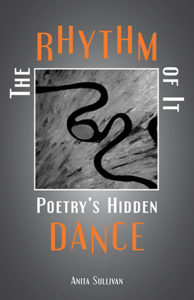
The Rhythm of It, Poetry’s Hidden Dance by Anita Sullivan
Shanti Arts Publishing, 2019, 118 pages, $14.95
ISBN: 978-1-951651-03-9 (softcover)
Available at http://shantiarts.com
Author web site: https://www.anitasullivan.org
The Rhythm of It, Poetry’s Hidden Dance by Anita Sullivan is a collection of essays brimming with ideas that accompany the author’s mindful and body-movement exploration of poetry. These seventeen essays offer glimpses into the physical experience of poetry, often bringing forth aspects that seem to be hidden in plain sight—and that may help us find our own route into writing new poems.
In the essay “Tai Chi Time,” Sullivan finds herself distracted by the rhythmic ticking of a wall clock:
What does this mean about Time? I briefly wonder.
Humans do rhythm, which is connected to a different kind of time than what this hapless
device insists upon … (16)
Reading these ruminations, I frequently paused to consider my own experiences. I also have been distracted by an eerily clicking wall clock that, once noticed, became the only sound in the room; yet, I did not think to write that experience into anything more. Throughout this book, Sullivan demonstrates determination to find more meaning. The sound of the clock ticking turns out to be a useful distraction. Shifting focus to the silence between the ticks, she considers how poems arise and how they convey the value of silence. Within this line of inquiry, she moves on to consider the distinction between silence and quiet. While searching for places where poems arise, she tracks across a terrain of feelings, rhythms, and sound—and, like the elephant in the room, the ticking clock periodically reappears.
In “The Pulse,” Sullivan considers the difference between clock-time and the human-time in which we breathe and move:
The clock is not making pulses that constantly quiver with the possibilities for slight variance; rather it is pounding equidistant stakes into the ocean of time. (20)
Like following a breadcrumb trail of ideas, I lingered here, contemplating time as an ocean rather than a line, and appreciated being surprised by each new perspective. Even when I was certain that all the meaning had been prodded from a point of reflection, Sullivan doubled back, rotating her original premise just enough to reveal another aspect.
Rhythm is a big deal for poems whether through rhyme or “a skillful laying on of numerically-guided metric frameworks …” (25); and, yet, after a nod to prosody, Sullivan questions her reaction to a new poem:
Do I start to sway in a dance that draws upon old patterns scratched onto my bones like petroglyphs? (26)
I appreciate that, in our current time of gilded technology, Sullivan asks probing questions as if we might relearn our profound ties to the past.
The Rhythm of It offers a language-rich journey through ideas and possibilities and––as if I’m the subversive one––I notice opportunities to extend, borrow, or repurpose. I see essay titles begging to be written into a poem, or into a thousand poems: “We Spin.” “A Nod to Whim.” “The Pulse.” “Plain Speech.” “Why Rhythm and Not Something Else Instead or Also.” Several essays also include epigraphs which thoughtfully highlight aspects of the essay as well as suggesting more opportunities for reflection or reuse.
Each essay also includes a page of artwork that relates to deep history or nature: a line drawing resembling a petroglyph with a humanoid figure engaged in some activity, or a graphically strong photograph that might be a river or bay, or trees—and, like a poem, may be interpreted in more than one way.
The Rhythm of It is a lovely book laced with questions and insightful meditations. Sullivan shares her stories and ideas as she engages in an intellectual and body-movement adventure with language—through Tai Chi, clocks, mathematics, music, chant, deep history, and walking. She demonstrates asking questions and “feeling” rhythm so that it’s as if language fleetingly plays 2ndfiddle to the subconscious—which, of course, is somewhere that poems hide.
I wholeheartedly recommend The Rhythm of It to everyone who has a thoughtful relationship with language and is mindful about life. Something will come of it.
Reviewer Bio:
Katie Eberhart’s book Cabin 135, A Memoir of Alaska will be available from University of Alaska Press in August 2020. Katie has an MFA from Rainier Writing Workshop (PLU). Her poems, essays, and articles have appeared in Cirque Journal, Sand Journal, Crab Creek Review, Northwest Accordion News, and other places. Uttered Chaos Press (Eugene, OR) published her chapbook Unbound: Alaska Poems in 2013. Katie currently resides in Oregon where she studies accordion, arranges music, plays 2nd violin in the Bend Pops Orchestra, and is finding her way back to writing poetry. Katie’s web site is http://katieeberhart.com
